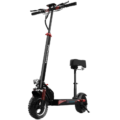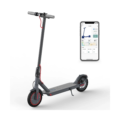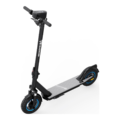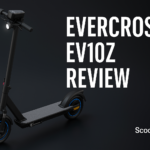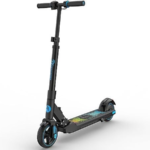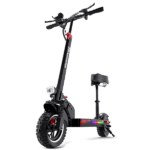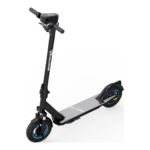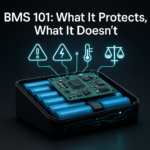- Home
- Scooters
- Electric Scooters
- EVERCROSS EV10K Pro
EVERCROSS EV10K Pro
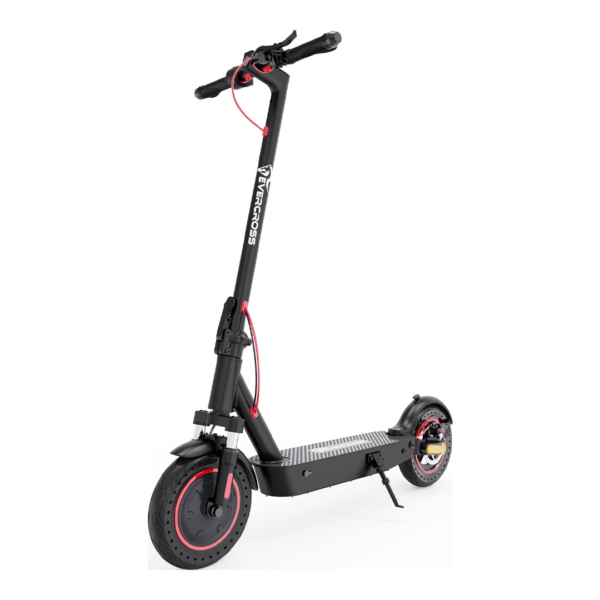

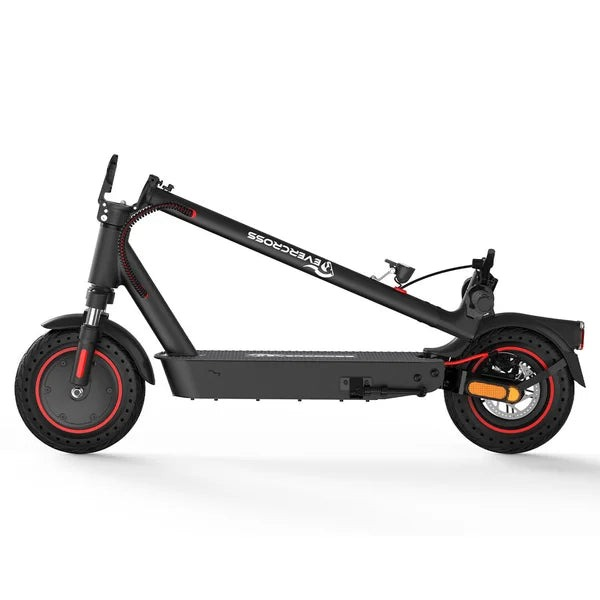

- Battery Range: 22–25 miles (35–40 km)
- Top Speed: 18.6 mph (30 km/h)
- Motor Power: 500 W
- Weight Capacity: 330 lb (150 kg)
- Charging Time: ~6–8 h
- Scooter Weight: 35.3 lb (16.0 kg)
PROS
- Turn signals + LED lighting
- Dual braking: electronic + rear disc
- 10″ honeycomb tires (no flats)
- App with lock & speed control
- Front & rear suspension
- Folds compact (43.3×20.1×21.3 in)
CONS
- Solid tires transmit more vibration
- Range depends on rider/terrain
- IP rating not published
- 19 mph requires unlocking in app

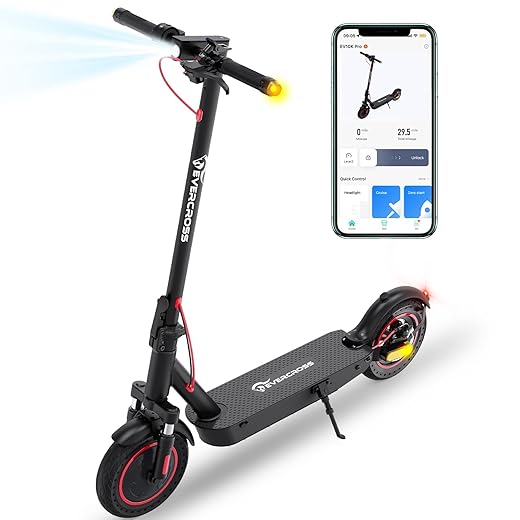
Table of contents
- What Is the EVERCROSS EV10K Pro?
- How the EVERCROSS EV10K Pro Works
- Key Specifications
- Design & Build Quality
- Performance Fundamentals
- Battery, Range & Efficiency
- Ride Quality & Comfort
- Braking & Safety Features
- Portability & Daily Usability
- Maintenance & Care
- Weather & Seasonal Considerations
- EVERCROSS EV10K Pro vs Alternatives
- Who the EVERCROSS EV10K Pro Is (and Isn’t) For
- FAQs
- Glossary
- Final Thoughts
The EVERCROSS EV10K Pro is a compact, app-enabled electric scooter designed for everyday city travel. It pairs a 500W brushless hub motor with 10-inch honeycomb tires, dual suspension, and a quick-fold frame. As a result, it suits riders who want reliable commuting range, predictable handling, and low-maintenance tires without giving up essentials like turn signals, cruise control, and a clear LED display.
What Is the EVERCROSS EV10K Pro?
At its core, the EVERCROSS EV10K Pro is a city-class e-scooter that prioritizes practicality. The platform uses a 36V lithium-ion pack (regionally listed around 11.4–12 Ah) and a 500W motor to deliver a manufacturer-rated top speed of about 30 km/h (18.6 mph) when unlocked through the display or app. In many regions, the standard cap is 25 km/h (15.5 mph), which aligns with common urban regulations. Consequently, riders can tailor top speed to local norms and personal comfort.
Moreover, the chassis carries 10-inch honeycomb solid tires and front-and-rear shock absorption. Because of that combination, you get puncture resistance plus a bit of suspension support over cracks, cobbles, or concrete seams. Stopping power comes from a mechanical disc brake supplemented by electronic braking (E-ABS). Meanwhile, the cockpit keeps things simple: a central LED dashboard, a single multi-function power button, a brake lever, and dedicated turn-signal controls. Additionally, the EVERCROSS PRO app lets you lock the scooter, select modes, toggle cruise control, and view basic ride data.
Despite its commuter focus, the EV10K Pro isn’t barebones. It includes integrated lighting, a kickstand, a bell, and a three-step folding mechanism. Folded, it measures roughly 110 × 51 × 54 cm (43.3 × 20.1 × 21.3 in), so it fits under most desks or in a car trunk. Unfolded, the height is about 118 cm (46.5 in). The net weight is around 16 kg (35.3 lb), which many riders can carry up a flight of stairs without strain. Altogether, these specifications align well with daily city use and multi-modal commutes.
How the EVERCROSS EV10K Pro Works
Although electric scooters can feel complex, the EV10K Pro is straightforward once you break it down.
Motor. The 500W brushless hub motor is integrated into one wheel. Picture it as a compact, sealed donut that spins the wheel directly. Because there are no chains or belts, power delivery stays smooth and quiet, with minimal routine upkeep. Furthermore, the sealed layout helps in dusty conditions.
Controller. Think of the controller as the scooter’s “brain.” It interprets throttle input, limits current to protect the battery and motor, and blends electronic braking with mechanical braking when you slow down. It also manages speed modes and cruise control. Therefore, you get consistent responses even when the road surface changes.
Battery. The 36V lithium-ion pack stores the scooter’s energy. The capacity listed by the brand varies slightly by region (about 11.4–12 Ah), which translates to roughly 410–432 Wh. Under favorable conditions, EVERCROSS quotes up to ~35–40 km (22–25 miles). In practice, those numbers are a ceiling; real streets rarely replicate lab conditions.
Throttle. The thumb throttle on the right side modulates speed. A gentle press eases you away from a stop; a firmer press calls for more current. Because the controller meters power, acceleration feels measured rather than jerky. As a result, new riders adapt quickly.
Brakes. The rear disc brake provides the primary stopping force. Meanwhile, the electronic brake (E-ABS) adds motor resistance when you release the throttle or apply the lever. The combo shortens stopping distance and helps stabilize the chassis. However, you should still leave extra room on dusty or wet surfaces.
This system design aims for predictable control in busy urban traffic. As you ride, you’ll feel the EV10K Pro settle into a steady pace and respond consistently to small throttle inputs, which reduces fatigue on longer commutes. In short, the control scheme favors calm, repeatable feedback.
Key Specifications
The table below consolidates the most relevant EV10K Pro specifications in one place. Values reflect the manufacturer’s published data and common regional variants.
| Category | Details |
|---|---|
| General | Model: EVERCROSS EV10K Pro • Class: City/commuter e-scooter • Wheel size: 10 in (25.4 cm) honeycomb solid tires • Display: LED dashboard • App: EVERCROSS PRO (Bluetooth) |
| Performance & Power | Motor: 500W brushless hub • Top speed (unlocked): ~30 km/h (18.6 mph) • Typical regional cap: 25 km/h (15.5 mph) • Max incline: stated up to ~20% (≈11°) • Ride modes incl. Pedestrian (≈6 km/h / 3.7 mph) |
| Battery, Charging & Electrical | Battery: 36V lithium-ion, ~11.4–12 Ah (≈410–432 Wh) • Claimed range: ~35–40 km (22–25 miles) • Charge time: ~6–8 hours • Charging: DC port with protective cap • Electronic braking: E-ABS |
| Build & Dimensions | Frame: aluminum alloy • Net weight: ~16 kg (35.3 lb) • Unfolded size: ~110 × 51 × 118 cm (43.3 × 20.1 × 46.5 in) • Folded size: ~110 × 51 × 54 cm (43.3 × 20.1 × 21.3 in) • Deck: wide stance platform |
| Safety & Control | Brakes: rear disc + electronic brake (E-ABS) • Front & rear suspension • Lights: headlight, tail/brake light, turn signals • Reflectors: integrated • Bell: yes |
| Features & Extras | Cruise control • App lock/unlock • Speed mode selection • LED display with speed/battery/mode • Kickstand • Quick 3-step fold |
| Warranty & Compliance | Warranty: up to 18 months (region-dependent) • EU road compliance: 25 km/h-aligned urban use (regional laws vary) |
Design & Build Quality
The EV10K Pro’s frame uses aluminum alloy tubing with clean welds and a matte paint finish. The lines are simple and purposeful. Because the deck sits low, you get stable footing at speed and a comfortable stance while coasting. The deck rubber grips well in the wet, and it resists scuffs after repeated use. Additionally, the edges are rounded enough to be shin-friendly during tight turns.
The stem folds forward using a latch-and-hook arrangement. The quick-release lever includes a safety catch that requires intent to open, which helps prevent accidental unlatching. When you lock the stem upright, the assembly clicks firmly. There’s minimal play at the hinge when new, and you can tune it with basic tools. Moreover, the hinge hardware is accessible, so small adjustments take minutes rather than hours.
Up top, the cockpit is uncluttered. The LED dashboard sits center, and the single power button cycles modes and lights. On the right, the thumb throttle has a short, smooth throw. On the left, you’ll find the brake lever, a bell, and the turn-signal controls. The layout favors intuitive operation, so you won’t hunt for switches while riding. Likewise, the display remains legible in bright sun due to high-contrast digits.
Underneath, the 10-inch honeycomb tires reduce maintenance. They can’t go flat, and the hex-cell structure adds compliance over rough patches. Paired with the dual suspension, the scooter filters small chatter effectively. That said, solid tires still transmit more vibration than high-quality pneumatic tires at the same diameter. EVERCROSS offsets this with a widened deck and a stable steering geometry that calms the ride. Consequently, you get calm tracking on uneven paving stones and patched asphalt.
Fit-and-finish is consistent for the class. Panel gaps are even, harness routing is tidy, and the charge-port cover seats flush. Over time, plan to check the folding latch and the front headset bolts, as on any folding scooter. Finally, add a tiny dab of threadlocker to non-service fasteners if you notice them backing out.
Performance Fundamentals
Start and acceleration. From a standstill, the EV10K Pro steps off progressively. The controller ramps power smoothly, which helps new riders. In standard mode, it eases to cruising speed without drama. In quicker modes, throttle response sharpens, yet it remains predictable. Because the 500W motor focuses on balance rather than brute force, the scooter accelerates best from a rolling start rather than a hard push. Even so, it keeps up with bike-lane traffic comfortably.
Cruising stability. At neighborhood speeds, the chassis tracks straight and feels planted. The combination of a low deck, 10-inch diameter, and solid tires favors stability over twitchiness. As you approach the top of the speed range, you still get a calm steering feel. Nevertheless, keep your weight neutral and grip light; that stance reduces the chance of minor wobble on rough asphalt. In addition, scanning ahead for seams helps you glide rather than jab the bars.
Hill behavior. On typical commuter grades around 7–10%, the EV10K Pro holds speed reasonably well in higher modes. It slows on steeper ramps, as expected in this power class, but it continues climbing in a steady, controlled way. For the best result, enter a hill with some momentum and keep the throttle steady. If you ride in a hilly area consistently, consider leaving a small margin in your time estimates. Likewise, shift your stance forward slightly to keep weight on the front wheel for better steering.
Battery, Range & Efficiency
The power pack operates at 36V with a regional capacity listing around 11.4–12 Ah. That’s roughly 410–432 Wh of energy. Under ideal lab-style conditions—smooth pavement, mild temperatures, lighter rider, and low-to-medium speed—the brand claims up to about 35–40 km (22–25 miles). Consequently, riders who favor efficient cruising and flat terrain will see the best results.
Real-world range varies, as it always does. Rider weight, frequent stops, temperature, headwinds, tire condition, and hills all affect consumption. Taller riders with more wind exposure will also see a difference. That said, careful throttle use and a consistent cruising pace can deliver range that approaches the upper end of the manufacturer’s claim on flat routes. Likewise, keeping the deck gear-free and the backpack light reduces drag and load.
Charging. The included charger plugs into a DC barrel port protected by a rubber cap. Expect roughly 6–8 hours for a full charge from low. Because lithium-ion cells prefer shallow cycles, you’ll extend lifespan by avoiding full discharges. If you commute daily, topping to 80–90% and storing the scooter at moderate charge during long breaks helps. Additionally, charge at room temperature for best cell health.
Efficiency tips. Keep speeds steady, reduce unnecessary starts, and anticipate stops. Use cruise control on long boulevard stretches. Additionally, check that the brake rotor isn’t rubbing and that the tire tread remains clean. Small drags add up over a commute. Finally, consider a smoother line through turns; momentum saved is energy saved.
Ride Quality & Comfort
Comfort on small-wheeled scooters depends on three things: tire behavior, suspension tuning, and chassis geometry. The EV10K Pro uses honeycomb solid tires that can’t puncture and don’t need air. They ride firmer than pneumatic alternatives, yet the hex pattern and rubber compound add compliance. Dual suspension then removes the edge on expansion joints and cracked surfaces. Consequently, the scooter remains controllable on the broken pavement common to many cities.
Ergonomics. The deck offers ample stance room, which encourages a relaxed, offset foot position. With the bar adjusted to its fixed height, average-height riders get a natural elbow bend. Because the scooter is compact, taller riders will prefer a looser arm posture to keep handling smooth. Stem flex is minimal when the hinge is adjusted correctly. Likewise, the grippy deck pad helps you stay planted during quick stops.
Noise and vibration. The motor runs quietly, and there’s little gear whine. You may hear the tread pattern on certain pavements, which is normal for solid tires. If you notice any new rattles, check the latch area and accessory screws first. A small dab of threadlocker on non-service fasteners can also help. Moreover, a periodic wipe-down of the headset area keeps dust away from moving parts.
Braking & Safety Features
The EV10K Pro combines a rear mechanical disc with electronic braking (E-ABS). Light lever input brings on electronic drag first, which feels like gentle engine braking. As you squeeze further, the disc takes the load. Because the two systems blend, initial deceleration is smooth and predictable. Then, when the disc comes in, you feel a firmer bite and stronger slowdown. Therefore, you can fine-tune stopping force without abrupt weight shifts.
Modulation. The lever travel is short, and the bite comes after roughly half-pull. This tuning helps you avoid skids on dusty pavement. If you ride frequently in wet conditions, brake earlier and keep the scooter upright while slowing. Additionally, keep both feet aligned and knees slightly bent to absorb weight transfer.
Lighting and signals. Up front, the headlight provides a bright, focused beam for urban speeds. The tail light brightens under braking, and the bar-mounted turn-signal buttons click positively. Signal early and keep your lane position clear; drivers notice a moving light sooner than a small hand signal. Furthermore, reflectors on the sides aid visibility at intersections.
Water exposure. The manufacturer doesn’t publish a formal IP rating for this model. Therefore, avoid riding through standing water, pressure-washing the deck, or charging when wet. Wipe the scooter down after light rain, and store it indoors. In addition, dry the charge-port area before plugging in to protect contacts.
Portability & Daily Usability
At roughly 16 kg (35.3 lb), the EV10K Pro is manageable for most adults. The folded size—about 110 × 51 × 54 cm (43.3 × 20.1 × 21.3 in)—slides into a hatchback, elevator, or office corner. Because the fold is a quick three-step process, you can collapse it at a train platform without drama. Moreover, the latch feels secure once locked, which reduces creaks while carrying.
Carrying. Grab the stem near the clamp, lift from the legs and hips, and keep the deck against your thigh for balance. If you regularly carry it upstairs, consider a simple strap to free one hand. Additionally, plan your route to avoid long detours through stairwells when possible.
Storage. Keep it in a dry spot away from direct sun and heaters. If you plan a break longer than a month, leave the battery around 50–70% and top up briefly every few weeks. Additionally, check the charge-port cap each time; it prevents grit from entering. Finally, make sure the folding latch is relaxed (not under tension) during long storage to preserve clamping force.
Security. A sturdy U-lock through the rear wheel and frame deters quick grabs. The app lock adds a layer of deterrence by cutting motor power, but it doesn’t replace a physical lock. Treat it as a complement, not a primary defense. Likewise, park in sight lines and under lighting whenever possible.
Maintenance & Care
A simple routine keeps the EV10K Pro crisp and safe.
Before each ride (30 seconds).
Scan the tires for embedded debris. Squeeze the brake lever; confirm firm feel. Check the latch and the handlebar clamp. Finally, verify lights and signals. Consequently, you catch issues early.
Weekly (or every ~50 miles / 80 km).
- Wipe the scooter clean. Dust around the brake and caliper.
- Inspect rotor alignment and listen for rub; adjust the caliper if needed.
- Check axle nuts and hinge bolts for snugness.
- Confirm the kickstand mount remains tight.
- Open the app and scan for firmware prompts; update only when you have full battery and time to test.
Additionally, spin the wheels by hand; drag or scraping sounds signal small fixes before they grow.
Monthly.
- Examine tread wear; replace tires when the pattern rounds off significantly.
- Inspect brake pads for glazing or thinning.
- Clean and re-lube the folding hinge as specified by the brand.
- Review the charge port and cap for damage.
Moreover, consider a bolt-by-bolt torque check each quarter if you ride daily.
Battery habits.
Avoid deep discharges. Charge at room temperature. Unplug once full. If you finish a wet ride, let the scooter dry before charging. In addition, store at a moderate state of charge when off the road for weeks.
Weather & Seasonal Considerations
Rain. Solid tires resist punctures, yet wet steel plates, paint lines, and leaves remain slick. Therefore, reduce speed, extend following distance, and keep inputs gentle. Dry the scooter after the ride and avoid puddles that mask potholes. Furthermore, consider a slow-in, straight-out cornering approach on glossy surfaces.
Cold. Lithium-ion chemistry loses capacity in low temperatures. You may see a noticeable range drop below ~10°C (50°F). If possible, charge and store indoors. Ride conservatively and expect an earlier stop for the day. Likewise, warm the scooter briefly inside before charging to protect the cells.
Heat. High ambient temperatures can raise battery and controller temps. Park in shade, and avoid leaving the scooter in a hot trunk for hours. If the scooter feels unusually warm after a steep climb, pause briefly. Additionally, ventilate storage spaces to help the pack cool.
Dust and grit. Over time, fine debris accumulates around the brake and hinge. Clean those areas first. Because the EV10K Pro relies on solid tires, you won’t deal with flats, but debris can still wedge in the honeycomb and vibrate—another reason to brush the tread regularly. In short, a clean scooter rides better.
EVERCROSS EV10K Pro vs Alternatives
Within the commuter category, scooters split into three broad groups:
- Light commuters (sub-12 kg / 26 lb). These carry easier and fold smaller, yet they usually trade away suspension, turn signals, and range. Compared with them, the EVERCROSS EV10K Pro offers more comfort, better hill capability, and broader feature coverage. However, it weighs a bit more.
- Mid commuters (12–18 kg / 26–40 lb). This is the EV10K Pro’s home turf. Here, it stands out with dual suspension, honeycomb tires, turn signals, and a balanced 500W tune. Some peers use pneumatic tires that ride softer, but they also puncture. Choose based on your tolerance for flat repairs versus vibration. Additionally, compare specifications like battery watt-hours and brake type to match your routes.
- Performance commuters (18–25+ kg / 40–55+ lb). Bigger decks, dual motors, and higher voltages raise speed and hill power, yet they complicate carrying and storage. If you want top-end thrust or 40+ mile ranges, consider that class. If you prioritize portability and practical features, the EV10K Pro stays the simpler choice. On the other hand, the heavier class wins on raw acceleration.
Off-road models add knobby tires and long-travel suspension. They shine on trails, but they’re heavier and less efficient on pavement. The EV10K Pro is tuned for streets and bike lanes, not dirt. Therefore, choose trail-oriented scooters only if your routes are actually off-road.
For a lighter, simpler city scooter with a lower learning curve, consider the EVERCROSS EV08E as an alternative.
Who the EVERCROSS EV10K Pro Is (and Isn’t) For
Ideal for:
- Daily city commutes of 8–16 km (5–10 miles) each way.
- Students or office workers who need a scooter that folds quickly and fits in small spaces.
- Riders who prefer solid tires to avoid flats.
- Multi-modal travelers who connect with buses or trains and want cruise control for the straight sections.
Additionally, it suits riders who value steady handling over wild acceleration.
Not ideal for:
- Heavy, sustained hills above the moderate range. While the scooter can climb, frequent steep grades erode speed and range.
- Riders wanting plush, pneumatic-level comfort. The honeycomb tires and dual suspension help, yet they can’t fully match high-quality air tires.
- Long-distance touring. The rated range is practical, but performance models with larger batteries suit all-day rides better.
Likewise, aggressive off-road use sits outside this scooter’s mission.
If your budget is tight, you may prefer one of the best electric scooters under $200 in 2025 for basic short trips.
FAQs
1) How fast does the EVERCROSS EV10K Pro go?
Unlocked through the display/app, it targets ~30 km/h (18.6 mph). In many regions, the standard limit is about 25 km/h (15.5 mph). Therefore, the final number depends on mode and local rules.
2) What range can I expect day to day?
Plan around 20–30 km (12–18 miles) for mixed city riding. Careful throttle use, flat terrain, and mild temperatures can push you closer to the upper claim. Conversely, hills and headwinds lower range.
3) Can I ride in the rain?
Light splashes happen, but the brand does not publish a formal IP rating. Therefore, avoid puddles, store the scooter dry, and never charge while wet. Additionally, slow down on painted lines.
4) Does it have cruise control?
Yes. You can enable cruise in the settings and hold a steady speed on long, straight sections. Moreover, canceling is easy with a lever pull or throttle change.
5) What brakes does it use?
A rear disc brake works with electronic braking (E-ABS). The combo gives smooth initial slowdown and stronger bite as you squeeze the lever. Consequently, you can modulate stops precisely.
6) Is the EVERCROSS EV10K Pro good for hills?
It handles typical urban grades around 7–10% respectably in higher modes. On steeper hills, expect slower speeds but steady progress. In addition, entering with momentum helps.
7) Do the specifications vary by region?
Small differences occur, especially in capacity listings and speed caps. Even so, the overall package remains consistent. For clarity, this EVERCROSS EV10K Pro overview reflects mainstream variants.
Glossary
Ah (amp-hours). A measure of battery capacity; higher Ah typically means more stored energy at the same voltage.
Wh (watt-hours). Battery energy (voltage × capacity). Useful for comparing real range potential.
Controller. The electronics module that regulates power flow between the battery and motor.
Brushless hub motor. A motor built into the wheel that spins the tire directly.
E-ABS (electronic braking). Electronic resistance within the motor used to slow the scooter.
Regen. Informal term for recovery of small amounts of energy under electronic braking.
Stem flex. Slight movement at the handlebar stem under load; proper latch adjustment minimizes it.
IP rating. Ingress Protection code for dust and water. If not published, ride conservatively in wet conditions.
Pedestrian mode. A low-speed setting (around 6 km/h / 3.7 mph) useful for walking zones.
Cruise control. A feature that maintains a set speed until you brake or change input.
Torque. Rotational force from the motor that determines launch feel and hill ability.
Solid (honeycomb) tire. Airless tire designed to resist punctures while adding some compliance via internal cells.
Suspension. Springs and dampers that reduce shocks from bumps and surface imperfections.
Top speed unlock. A setting that raises the limiter; check local rules before using it.
Wheelbase. Distance between front and rear axles; influences stability and steering feel.
Deck pad. The grippy surface layer you stand on; it boosts stability under braking.
Modulation. The fine control you have over braking force across the lever’s travel.
Final Thoughts
The EVERCROSS EV10K Pro focuses on everyday riding: straightforward controls, important safety lighting, manageable weight, and a feature set that covers real commuting needs. It trades the velvety ride of air tires for the no-flat confidence of honeycomb rubber. It also keeps power sensible, which helps with battery life and smoothness. Consequently, the scooter feels composed on real streets rather than tuned just for spec sheets.
If you want a low-hassle scooter for city streets, school runs, and last-mile hops, this model checks the right boxes. Pair steady riding habits with simple care, and it should serve as a calm, predictable partner on your daily loop. Overall, it balances practicality, portability, and durability in a way that fits modern urban routines.
Specifications
General
| Model The Model specifies the exact version or name of the scooter. It helps identify its unique design, features, and specifications within the manufacturer’s product line. Knowing the model makes it easier to compare options, find compatible accessories, or look up support information. | EV10K Pro |
| Brand The Brand identifies the manufacturer or company that designs and produces the scooter. A trusted brand is a sign of quality, reliability, and good customer support. Well-known brands often have higher standards for safety, performance, and after-sales service, giving you more confidence in your purchase. | EVERCROSS |
| Release Date The Release Date indicates when the scooter model was officially launched on the market. This helps you know how current the design, technology, and features are. A newer release date often means updated components, improved performance, and the latest safety or smart features. | 17 November 2025 |
| Recommended Age Recommended Age indicates the minimum age range that the scooter is designed for, based on safety, size, and ease of use. Following the recommended age helps ensure that riders can handle the scooter’s speed, weight, and controls comfortably and safely. Always check local laws and use protective gear, especially for younger riders. | +16 |
Performance & Power
| Motor Power (Wattage) What it means: The motor power, measured in watts (W), shows how strong the scooter’s electric motor is. Why it matters: Higher wattage usually means better acceleration, more torque, and improved performance on hills or rough terrain. For example, a 250W motor is good for flat city roads and light riders, while a 500W or 1000W motor provides more power for faster speeds or climbing steep inclines. | 500 W rear hub motor |
| Top Speed The Top Speed indicates the maximum speed that the scooter can reach under optimal conditions. It’s usually measured on level ground with a fully charged battery and an average rider weight. A higher top speed allows you to travel longer distances faster, but always ensure you ride within legal speed limits and your personal comfort zone for safety. | 18.6 mph (30 km/h) — 19 mph unlockable via app |
| Battery Capacity Battery Capacity refers to the total amount of energy the scooter’s battery can store, usually measured in ampere-hours (Ah) or watt-hours (Wh). A higher battery capacity means you can ride longer distances on a single charge, reducing the need for frequent recharging. Keep in mind that actual range can vary depending on rider weight, terrain, speed, and weather conditions. | 36 V 12 Ah (432 Wh) |
| Estimated Range per Charge The Estimated Range per Charge indicates the average distance the scooter can travel on a single full battery charge. This range is calculated under optimal conditions, such as flat terrain, moderate speed, and average rider weight. Real-world range may vary depending on riding style, terrain, weather, and load. A longer range means fewer recharges and greater freedom for longer trips. | 22–25 miles (35–40 km) |
| Hill Climb Ability Hill Climb Ability describes the maximum incline or slope that the scooter can handle while maintaining stable performance. It’s typically expressed as a percentage or in degrees. A higher hill climb rating means the scooter can tackle steeper hills without losing too much speed or power. Actual climbing performance may vary based on rider weight, battery charge, and terrain conditions. | Up to 20% grade |
| Drive System The Drive System refers to how power from the motor is delivered to the wheels. Electric scooters typically use either a hub motor (directly integrated into the wheel) or a chain/belt drive system. A high-quality drive system ensures smooth acceleration, efficient power transfer, and low maintenance. The choice of drive system affects performance, noise level, and overall ride experience. | Rear hub (RWD) |
Charging & Electrical
| Charging Time Charging Time indicates how long it takes to fully recharge the scooter’s battery from empty to 100% using the standard charger provided. Faster charging means less downtime and more time on the road. Actual charging time may vary slightly depending on battery capacity, charger output, and environmental conditions. | Approx. 6–8 hours |
| Battery Type Battery Type refers to the specific technology used in the scooter’s battery, which affects performance, lifespan, weight, and charging time. Most modern electric scooters use high-quality lithium-ion (Li-ion) batteries because they offer a good balance of energy density, durability, and low maintenance. A reliable battery type ensures consistent power delivery and longer riding ranges. | Lithium-ion pack with Smart BMS |
| Removable Battery A Removable Battery means the battery pack can be easily detached from the scooter for convenient charging and replacement. This feature allows you to charge the battery separately, swap it with a spare for extended range, or securely store it indoors in extreme weather. Removable batteries add flexibility and make it easier to keep your scooter powered up wherever you are. | Non-removable internal battery |
| Regenerative Braking Regenerative Braking is an energy-saving feature that converts some of the energy normally lost during braking back into battery power. When you slow down or brake, the motor works in reverse to generate electricity, which helps extend the scooter’s range and improves overall efficiency. This system also reduces wear on traditional brake components, leading to lower maintenance over time. | Yes (via electronic brake) |
| Lighting Lighting refers to the built-in front and rear lights that enhance visibility and safety when riding in low-light conditions or at night. Good lighting helps you see the road ahead and ensures that other road users can see you. Many scooters include LED headlights, taillights, and sometimes brake lights or side reflectors for added safety and compliance with local traffic regulations. | LED headlight + rear brake light + turn signals |
Build & Dimensions
| Scooter Weight Scooter Weight refers to the total weight of the scooter when fully assembled, including the battery. This affects how easy it is to carry, lift, and store the scooter when not in use. A lighter scooter is more portable and convenient for commuting, especially if you need to carry it upstairs or onto public transport. Keep in mind that a sturdy frame and quality components may add to the weight but also contribute to better durability and ride stability. | 35.3 lb (16.0 kg) |
| Maximum Rider Weight Maximum Rider Weight indicates the highest rider weight that the scooter is designed to safely support while maintaining optimal performance and stability. Staying within this limit helps ensure reliable acceleration, braking, and climbing ability, and it protects the frame, suspension, and motor from excessive strain. Exceeding the recommended limit may reduce performance and increase wear on components. | 330 lb (150 kg) |
| Deck Size Deck Size refers to the dimensions of the scooter’s standing platform. A wider and longer deck provides more foot space, allowing you to stand comfortably and adjust your stance while riding. A well-sized deck improves balance and stability, especially on longer rides or at higher speeds. Compact decks, on the other hand, help keep the scooter lightweight and portable. | Low deck; wide standing area |
| Handlebar Height Handlebar Height refers to the distance from the deck to the handlebars, which affects your riding posture and comfort. An appropriate handlebar height helps you maintain good balance, reduces strain on your back and arms, and makes steering more comfortable. Some scooters have adjustable handlebars to fit riders of different heights, while others have a fixed height for a streamlined design. | Fixed |
| Folding Mechanism The Folding Mechanism describes how easily and securely the scooter can be folded for carrying and storage. A well-designed folding system lets you quickly collapse the scooter into a compact size, making it convenient to transport on public transit, store under a desk, or fit into a car trunk. Look for sturdy latches and safety locks to ensure the scooter stays firmly in place when folded or unfolded. | Quick-latch stem fold |
| Dimensions Folded Dimensions indicate the size of the scooter when it’s fully folded. This measurement shows how much space the scooter will take up when stored or carried, making it easier to check if it will fit in your car trunk, under a desk, or in a closet. Compact folded dimensions are ideal for commuters who need to bring their scooter on public transport or store it in tight spaces. | Unfolded: 43.3×20.1×46.5 in (110×51×118 cm); Folded: 43.3×20.1×21.3 in (110×51×54 cm) |
| Material Material refers to the primary construction materials used for the scooter’s frame and key components. High-quality materials like aircraft-grade aluminum, reinforced steel, or durable composites provide strength, stability, and a lighter overall weight. A sturdy material ensures the scooter can handle daily wear and tear while maintaining safety and performance. | Aluminum alloy |
Safety & Control
| Brake Type(s) Brake Type(s) describe the braking systems the scooter uses to help you slow down or stop safely. Common brake types include mechanical brakes (like drum or disc brakes), electronic brakes, and foot brakes. Many scooters combine multiple braking systems for added safety and shorter stopping distances. The type and quality of brakes affect your control, especially when riding at higher speeds or on slopes. | Electronic brake + rear disc |
| Suspension Suspension refers to the system that absorbs shocks and vibrations while riding, providing a smoother and more comfortable ride over uneven or rough surfaces. Scooters may have front suspension, rear suspension, or dual suspension for better shock absorption and stability. Good suspension helps reduce rider fatigue and improves control, especially when riding on bumpy roads or off-road paths. | Front & rear suspension |
| Tire Type Tire Type refers to the kind of tires the scooter uses, which directly affects ride comfort, traction, and maintenance. Common types include solid (airless) tires, pneumatic (air-filled) tires, or hybrid options. Pneumatic tires offer better shock absorption and a smoother ride on rough surfaces, while solid tires are puncture-proof and require less upkeep. The right tire type helps ensure safe handling and a comfortable ride in different conditions. | 10″ honeycomb solid tires |
| Tire Size Tire Size indicates the diameter and width of the scooter’s tires, which affect ride comfort, stability, and how well the scooter handles different terrains. Larger tires generally offer better shock absorption and a smoother ride over bumps and rough surfaces, while smaller tires keep the scooter lighter and more portable. Choosing the right tire size helps ensure a balance between agility and comfort. | 10-inch |
| Kickstand The Kickstand is a built-in stand that allows you to park your scooter upright when it’s not in use. A sturdy kickstand keeps the scooter stable and prevents it from tipping over, protecting it from scratches and damage. It also makes storing and accessing your scooter more convenient, whether you’re at home, work, or on the go. | Side kickstand |
| Water Resistance Rating Water Resistance Rating indicates how well the scooter is protected against water and moisture, usually shown as an IP (Ingress Protection) rating. This rating helps you understand whether the scooter can handle light rain, splashes, or wet roads without damage. While most scooters are not fully waterproof, a good water resistance rating adds peace of mind when riding in changing weather conditions. Always avoid deep puddles or submerging the scooter to protect its electrical components. | Not specified |
Features & Extras
| Display/Console The Display (or Console) shows important real-time information about your ride, helping you monitor your scooter’s status at a glance. Typical displays show speed, battery level, distance traveled, and riding mode. Some models also include additional features like Bluetooth connectivity, app integration, or backlighting for better visibility at night. A clear and easy-to-read display enhances safety and convenience on every trip. | LED dashboard showing mode, speed, battery, BT |
| Ride Modes Ride Modes refer to the different speed and power settings you can choose to match your riding style or road conditions. Common modes include eco for maximum range and energy efficiency, standard for everyday balance, and sport or turbo for higher speed and stronger acceleration. Switching between ride modes allows you to customize performance, conserve battery, and ride safely in various environments. | 3 modes (Eco/Drive/Sport) |
| Smart App Connectivity Smart App Connectivity lets you pair your scooter with a dedicated mobile app via Bluetooth. Using the app, you can monitor real-time ride stats like speed, battery level, and range, adjust settings such as ride modes or cruise control, lock the scooter for added security, and sometimes receive firmware updates. This feature adds convenience and allows you to personalize your riding experience right from your smartphone. | EVERCROSS PRO app (lock, cruise, speed settings) |
| Anti-Theft System The Anti-Theft System helps protect your scooter from unauthorized use or theft. This feature can include built-in alarms, electronic motor locks, GPS tracking, or remote locking through a mobile app. A good anti-theft system provides peace of mind when parking your scooter in public spaces, adding an extra layer of security to safeguard your investment. | App lock; speed limit control |
| Cruise Control Cruise Control allows you to maintain a steady speed without continuously holding the throttle. This feature makes longer rides more comfortable by reducing hand fatigue and providing a smoother, more relaxed riding experience — especially on flat, open roads or bike lanes. For safety, cruise control can usually be easily activated or deactivated while riding. | Yes (cruise control) |
| Accessories Included Accessories Included lists the additional items that come with the scooter to enhance your riding experience and convenience. Common accessories may include a charger, kickstand, bell, lights, phone holder, or carrying strap. These extras add value by making your scooter safer, easier to use, and ready to ride straight out of the box. | Scooter, 42V 2A charger, tools, manual |
Warranty & Compliance
| Warranty Period The Warranty Period indicates how long the manufacturer guarantees the scooter against defects in materials and workmanship under normal use. A good warranty provides peace of mind, showing the brand’s confidence in its product quality. Always check what parts are covered, such as the frame, battery, and motor, and follow the maintenance guidelines to keep your warranty valid. | Region-dependent |
| Certifications Certifications confirm that the scooter meets specific safety, quality, and environmental standards set by recognized organizations or regulatory bodies. Common certifications may include CE, RoHS, UL, or other local compliance marks, depending on your region. These certifications ensure that the scooter is manufactured to high standards and is safe and legal to use in your country. | Local micromobility rules apply |
Price Comparison




